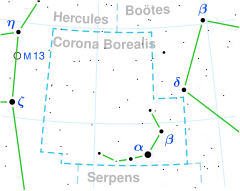Yellow-white hued star in the constellation Corona Borealis
Lambda Coronae Borealis , its name Latinised from λ Coronae Borealis , is a single[ 10] star in the northern constellation of Corona Borealis . In publications it is also identified as HR 5936 and HD 142908 . It has a yellow-white hue and is dimly visible to the naked eye with an apparent visual magnitude of 5.43.[ 2] light years based on parallax ,[ 1] radial velocity of −12 km/s.[ 5]
The stellar classification of Lambda Coronae Borealis is F2 IV-V,[ 3] main sequence and subgiant star. It has an estimated age of 1.4 billion years with a relatively high projected rotational velocity of 76 km/s.[ 8] [ 7] mass of the Sun and 2.1[ 1] Sun's radius . Based on the amount of iron in the atmosphere , the elemental abundances are similar to those in the Sun.[ 7] [ 1] luminosity of the Sun from its photosphere at an effective temperature of 6,991 K.[ 7]
The star displays an infrared excess with a signature that indicates a pair of circumstellar disks of dusty debris are orbiting the star. A blackbody fit to the higher temperature signal gives a temperature of 320 K with an orbital distance of AU [ 11]
A magnitude 11.44 visual companion was discovered by W. Herschel in 1782. As of 2015, it was located at an angular separation of ″ position angle of 68°.[ 12]
References
^ a b c d e f g h i j Brown, A. G. A. ; et al. (Gaia collaboration) (August 2018). "Gaia Data Release 2: Summary of the contents and survey properties" . Astronomy & Astrophysics 616 . A1. arXiv :1804.09365 Bibcode :2018A&A...616A...1G doi :10.1051/0004-6361/201833051 Gaia DR2 record for this source at VizieR .^ a b c Anderson, E.; Francis, Ch. (2012). "XHIP: An extended hipparcos compilation". Astronomy Letters . 38 (5): 331. arXiv :1108.4971 Bibcode :2012AstL...38..331A . doi :10.1134/S1063773712050015 . S2CID 119257644 . ^ a b Gray, R. O.; et al. (2001). "The Physical Basis of Luminosity Classification in the Late A-, F-, and Early G-Type Stars. II. Basic Parameters of Program Stars and the Role of Microturbulence" . The Astronomical Journal . 121 (4): 2159. Bibcode :2001AJ....121.2159G . doi :10.1086/319957 ^ Mermilliod, J.-C. (1986). "Compilation of Eggen's UBV data, transformed to UBV (unpublished)". Catalogue of Eggen's UBV Data . Bibcode :1986EgUBV........0M . ^ a b Gontcharov, G. A. (2006). "Pulkovo Compilation of Radial Velocities for 35 495 Hipparcos stars in a common system". Astronomy Letters . 32 (11): 759– 771. arXiv :1606.08053 Bibcode :2006AstL...32..759G . doi :10.1134/S1063773706110065 . S2CID 119231169 . ^ Holmberg, J.; et al. (2009). "The Geneva-Copenhagen survey of the solar neighbourhood. III. Improved distances, ages, and kinematics". Astronomy and Astrophysics . 501 (3): 941. arXiv :0811.3982 Bibcode :2009A&A...501..941H . doi :10.1051/0004-6361/200811191 . S2CID 118577511 . ^ a b c d Aguilera-Gómez, Claudia; et al. (June 2018). "Lithium abundance patterns of late-F stars: an in-depth analysis of the lithium desert". Astronomy & Astrophysics . 614 : 15. arXiv :1803.05922 Bibcode :2018A&A...614A..55A . doi :10.1051/0004-6361/201732209 . S2CID 62799777 . A55. ^ a b Ammler-von Eiff, Matthias; Reiners, Ansgar (June 2012), "New measurements of rotation and differential rotation in A-F stars: are there two populations of differentially rotating stars?", Astronomy & Astrophysics , 542 : A116, arXiv :1204.2459 Bibcode :2012A&A...542A.116A , doi :10.1051/0004-6361/201118724 , S2CID 53666672 . ^ "lam CrB" . SIMBAD Centre de données astronomiques de Strasbourg . Retrieved 2021-01-31 .^ Eggleton, P. P.; Tokovinin, A. A. (September 2008). "A catalogue of multiplicity among bright stellar systems" . Monthly Notices of the Royal Astronomical Society 389 (2): 869– 879. arXiv :0806.2878 Bibcode :2008MNRAS.389..869E . doi :10.1111/j.1365-2966.2008.13596.x S2CID 14878976 . ^ Cotten, Tara H.; Song, Inseok (July 2016). "A Comprehensive Census of Nearby Infrared Excess Stars" . The Astrophysical Journal Supplement Series . 225 (1): 24. arXiv :1606.01134 Bibcode :2016ApJS..225...15C . doi :10.3847/0067-0049/225/1/15 S2CID 118438871 . 15. ^ Mason, B. D.; et al. (2014). "The Washington Visual Double Star Catalog" . The Astronomical Journal . 122 (6): 3466. Bibcode :2001AJ....122.3466M . doi :10.1086/323920
